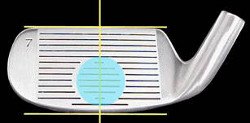
In golf, the “clubface” refers to the front surface of the clubhead that comes into contact with the golf ball during a swing. It is the part of the clubhead that directly influences the initial direction, launch angle, and spin of the ball.
Here are a few key points about the clubface:
- Impact on Ball Flight: The position and orientation of the clubface at impact greatly influence the initial direction and trajectory of the golf ball. The angle at which the clubface strikes the ball determines whether the ball will go straight, fade, or draw. A square clubface alignment at impact typically produces a straight shot, while an open or closed clubface leads to a fade or a draw, respectively.
- Loft and Face Angle: The clubface not only has loft, which is the angle between the face and the ground when the club is at rest, but it also has a face angle. The face angle refers to the alignment of the clubface in relation to the target line. A face angle that is closed (pointing left of the target for a right-handed golfer) will result in a shot that tends to go left, while an open face angle (pointing right of the target) will cause the ball to veer right.
- Clubface Technology: Manufacturers incorporate various technologies and designs into clubfaces to optimize performance. These technologies may include variable face thickness, face inserts, grooves, and surface textures, all aimed at enhancing ball speed, forgiveness, and control.
- Impact Location: The location on the clubface where the ball makes contact can significantly affect shot quality. Striking the ball in the sweet spot, which is the center of the clubface, produces maximum distance, accuracy, and optimal ball flight. Shots struck outside the sweet spot, toward the heel or toe of the clubface, may result in less distance and less control.
- Face Angle Adjustability: Some clubs, particularly drivers and fairway woods, offer adjustability features that allow golfers to modify the face angle. This adjustability can help fine-tune the ball flight and correct for specific swing tendencies or course conditions.
Understanding the clubface and its impact on ball flight is essential for golfers to control their shots effectively. Achieving a square clubface alignment at impact, consistently striking the ball in the sweet spot, and understanding how face angle influences shot shape are fundamental concepts in improving one's golf game. Golfers can work with professionals or consult club fitting experts to optimize their clubface alignment and maximize performance on the course.
The area used to strike the ball. The clubface of woods, hybrids and irons are marked with scoring lines or grooves, which impart backspin to the ball.





